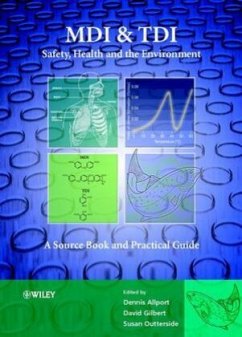Dennis Allport, David Gilbert, Susan OuttersideA Source Book and Practical Guide
MDI and Tdi: Safety, Health and the Environment
A Source Book and Practical Guide
Herausgegeben:Allport, D. C.; Gilbert, D. S.; Outterside, S. M.
Dennis Allport, David Gilbert, Susan OuttersideA Source Book and Practical Guide
MDI and Tdi: Safety, Health and the Environment
A Source Book and Practical Guide
Herausgegeben:Allport, D. C.; Gilbert, D. S.; Outterside, S. M.
- Gebundenes Buch
- Merkliste
- Auf die Merkliste
- Bewerten Bewerten
- Teilen
- Produkt teilen
- Produkterinnerung
- Produkterinnerung
MDI and TDI are polymer building blocks with a wide range of applications in industry. Both are used in large quantities and can be found in a wide variety of industries and applications. As their use will often involve large numbers of workers they are also subject to stringent health and safety regulations. This book covers all the important topics concerning MDI and TDI and provides comprehensive coverage on the health and environmental science associated with these. Considering the risk management of both substances this is the first book to offer comprehensive discussion of health and…mehr
Andere Kunden interessierten sich auch für
![Surface Complexation Modeling Surface Complexation Modeling]() Athanasios K KaramalidisSurface Complexation Modeling203,99 €
Athanasios K KaramalidisSurface Complexation Modeling203,99 €![Inorganic Reactions and Methods, the Formation of Bonds to C, Si, Ge, Sn, PB (Part 3) Inorganic Reactions and Methods, the Formation of Bonds to C, Si, Ge, Sn, PB (Part 3)]() J. J. Zuckerman (Hrsg.)Inorganic Reactions and Methods, the Formation of Bonds to C, Si, Ge, Sn, PB (Part 3)647,99 €
J. J. Zuckerman (Hrsg.)Inorganic Reactions and Methods, the Formation of Bonds to C, Si, Ge, Sn, PB (Part 3)647,99 €![Inorganic Reactions and Methods, the Formation of the Bond to Hydrogen (Part 2) Inorganic Reactions and Methods, the Formation of the Bond to Hydrogen (Part 2)]() J. J. Zuckerman (Hrsg.)Inorganic Reactions and Methods, the Formation of the Bond to Hydrogen (Part 2)617,99 €
J. J. Zuckerman (Hrsg.)Inorganic Reactions and Methods, the Formation of the Bond to Hydrogen (Part 2)617,99 €![Inorganic Reactions and Methods, the Formation of Bonds to Hydrogen (Part 1) Inorganic Reactions and Methods, the Formation of Bonds to Hydrogen (Part 1)]() J. J. Zuckerman (Hrsg.)Inorganic Reactions and Methods, the Formation of Bonds to Hydrogen (Part 1)617,99 €
J. J. Zuckerman (Hrsg.)Inorganic Reactions and Methods, the Formation of Bonds to Hydrogen (Part 1)617,99 €![Inorganic Reactions and Methods, the Formation of Bonds to N, P, As, Sb, Bi (Part 1) Inorganic Reactions and Methods, the Formation of Bonds to N, P, As, Sb, Bi (Part 1)]() J J ZuckermanInorganic Reactions and Methods, the Formation of Bonds to N, P, As, Sb, Bi (Part 1)627,99 €
J J ZuckermanInorganic Reactions and Methods, the Formation of Bonds to N, P, As, Sb, Bi (Part 1)627,99 €![Chirality in Transition Metal Chemistry Chirality in Transition Metal Chemistry]() Hani AmouriChirality in Transition Metal Chemistry228,99 €
Hani AmouriChirality in Transition Metal Chemistry228,99 €![Tin Chemistry Tin Chemistry]() Marcel GielenTin Chemistry398,99 €
Marcel GielenTin Chemistry398,99 €-
-
-
MDI and TDI are polymer building blocks with a wide range of applications in industry.
Both are used in large quantities and can be found in a wide variety of industries and applications. As their use will often involve large numbers of workers they are also subject to stringent health and safety regulations.
This book covers all the important topics concerning MDI and TDI and provides comprehensive coverage on the health and environmental science associated with these.
Considering the risk management of both substances this is the first book to offer comprehensive discussion of health and environmental issues and includes
_ insights from academic, regulatory, and industrial experts
_ numerous photographs, spectra, tables, and graphs
_ additional information on physical properties and analysis
_ Considers the risk management of these two diisocyanates
Addressing their use throughout industry this title presents an essential source of information for occupational physicians, industrial hygiene professionals, polyurethane producers, environmental scientists, chemical analysts and regulators.
Hinweis: Dieser Artikel kann nur an eine deutsche Lieferadresse ausgeliefert werden.
Both are used in large quantities and can be found in a wide variety of industries and applications. As their use will often involve large numbers of workers they are also subject to stringent health and safety regulations.
This book covers all the important topics concerning MDI and TDI and provides comprehensive coverage on the health and environmental science associated with these.
Considering the risk management of both substances this is the first book to offer comprehensive discussion of health and environmental issues and includes
_ insights from academic, regulatory, and industrial experts
_ numerous photographs, spectra, tables, and graphs
_ additional information on physical properties and analysis
_ Considers the risk management of these two diisocyanates
Addressing their use throughout industry this title presents an essential source of information for occupational physicians, industrial hygiene professionals, polyurethane producers, environmental scientists, chemical analysts and regulators.
Hinweis: Dieser Artikel kann nur an eine deutsche Lieferadresse ausgeliefert werden.
Produktdetails
- Produktdetails
- Verlag: Wiley & Sons
- 1. Auflage
- Seitenzahl: 490
- Erscheinungstermin: 7. Mai 2003
- Englisch
- Abmessung: 267mm x 203mm x 28mm
- Gewicht: 1292g
- ISBN-13: 9780471958123
- ISBN-10: 0471958123
- Artikelnr.: 10524294
- Herstellerkennzeichnung
- Libri GmbH
- Europaallee 1
- 36244 Bad Hersfeld
- gpsr@libri.de
- Verlag: Wiley & Sons
- 1. Auflage
- Seitenzahl: 490
- Erscheinungstermin: 7. Mai 2003
- Englisch
- Abmessung: 267mm x 203mm x 28mm
- Gewicht: 1292g
- ISBN-13: 9780471958123
- ISBN-10: 0471958123
- Artikelnr.: 10524294
- Herstellerkennzeichnung
- Libri GmbH
- Europaallee 1
- 36244 Bad Hersfeld
- gpsr@libri.de
D. C. Allport is the editor of MDI and TDI: Safety, Health and the Environment: A Source Book and Practical Guide, published by Wiley. D. S. Gilbert is the editor of MDI and TDI: Safety, Health and the Environment: A Source Book and Practical Guide, published by Wiley. S. M. Outterside is the editor of MDI and TDI: Safety, Health and the Environment: A Source Book and Practical Guide, published by Wiley.
List of authors and affiliations ix
A book of distinction xv
Acknowledgements xvii
MDI and TDI usage: responsible risk management 1
D C Allport, D S Gilbert and S M Outterside
Exposure, hazard and risk 1
Responsible Care®: a framework for industry action 5
Reading 10
1 MDI, TDI and the polyurethane industry 11
D C Allport, D S Gilbert and S M Outterside
Types of MDI 13
Types of TDI 15
Test substances 16
Misapprehensions 16
Polyurethanes made from MDI and TDI 17
Reading 23
2 Handling MDI and TDI 25
D C Allport, R C Blake, C Bastian, C Galavitz, D S Gilbert, R Hurd, B
Reeve, W Robert, S M Outterside, A Solinas, D Walsh, U Walber and H Wolfson
Pride in safety 25
Successful systems 25
Safety systems for the handling of MDI and TDI 26
Key Theme 1: Know your product 28
Health 31
Environment 32
Key Theme 2: Protecting health 33
Duty of care 33
Exposure: how can MDI or TDI enter the body? 34
Medical symptoms 35
Medical checks 36
Key Theme 3: Neutralization, decontamination and disposal of wastes 39
Types of neutralizer 40
Routine cleaning of equipment and drums 40
Neutralization after a spillage 43
Neutralizer formulations 46
Key Theme 4: Using personal protective equipment 47
Normal operations 47
Emergency situations 48
Selection of personal protective equipment 49
Protective clothing 50
Respiratory protection 51
Key Theme 5: Monitoring exposure 59
How should monitoring be carried out? 60
When should monitoring be carried out? 61
Key Theme 6: Dealing with accidents 62
Accidents can happen 62
Spillages 63
Development of excess pressure inside containers 68
Incidents involving fire 70
Transport of MDI and TDI 72
Transport regulations 73
MDI and TDI: transport temperatures 73
Typical containers for the transport of diisocyanates 75
Accidents and emergencies 85
The workplace: storage and use of MDI and TDI 86
Designing the systems and minimizing the risks 87
Physical and chemical properties relating to storage and processing 93
Storage of MDI and TDI 95
Safety issues in workplaces using MDI and TDI 106
Safety issues in some important polyurethane processes 117
Use of MDI and TDI in laboratories 122
Visitors to the workplace 123
Emergencies in the workplace 124
Releases to atmosphere from polyurethane manufacturing sites 126
Properties of MDI and TDI relevant to releases to atmosphere 127
Releases from polyurethane processes 127
Abatement of releases 138
Reading 148
3 Health 155
DC Allport, P Davies, W F Diller, J E Doe, F Floc'h H D Hoffmann, MKatoh
and J P Lyon. Appendices by D I Bernstein
Perspective on immediate effects following over exposure 156
First aid procedures 156
Commentary on first aid procedures 157
Human health: the medical background 160
Effects on the eyes 163
Effects on the skin 163
Effects when swallowed 165
Effects on the respiratory tract 165
Other health effects of MDI and TDI 185
Biomonitoring of MDI and TDI 186
Experimental toxicology 187
The interaction of MDI and TDI with biological systems 188
Toxicology studies 193
Diagnosis of diisocyanate asthma 203
Appendices (David I. Bernstein) 203
Reading 216
4 The environment 229
RE Bailey, A Gard, K H den Haan, F Heimbach, D Pemberton, II Tadokoro, M
Takatsuki and Y Yakabe
A general approach to environmental risk assessment 229
Exposure 233
Sources of exposure 233
Distribution and persistence 237
Biodegradation 256
Bioaccumulation 257
Hazard 258
Test procedures 258
Aquatic ecotoxicity 259
Terrestrial ecotoxicity 264
Risk assessment 265
Accidental release of MDI and TDI 266
Normal usage 268
Reading 273
5 Supporting sciences 277
5.1 Chemistry of manufacture of MDI and TDI 277
D C Allport, D S Gilbert and B Tury
Manufacture of MDI 277
Manufacture of TDI 280
Modified MDI and TDI 282
Reading 284
5.2 Structures and nomenclature 285
DC Allport, D S Gilbert and B Tury
Structures 285
CAS Registry numbers and preferred names 286
IUPAC names 287
Convenient names for MDI and TDI 288
Synonyms 289
Commercial product names 289
Reading 291
5.3 Chemical reactions of MDI and TDI 291
DC Allport, D S Gilbert, D Pemberton and B Tury
Reaction with -OH groups 292
Reaction with -NH groups 293
Reaction with -SH groups 293
Reaction with biological molecules 294
Self-reactions 295
Catalysts 298
Reading 299
5.4 Physical and fire properties 300
SM Outterside and D Pemberton
MDI 301
TDI 311
Reading 319
5.5 Fire behaviour of MDI and TDI 321
J F Chapman, B Cope, G Marlair and F Prager
Test methodology 321
Fire tests on MDI and TDI 323
Reading 340
5.6 Occupational exposure limits, stack limits and community limits 343
D C Allport, D S Gilbert, S M Outterside and B Tury
Occupational exposure limits 343
Stack release limits and community limits 351
Reading 357
5.7 Sampling and analysis 358
K S Brenner, V Dharmarajan and P Maddison
Materials to be measured 358
Airborne MDI and TDI species 359
Choice of methods for the sampling and analysis of MDI and TDI in air 360
Analysis of nonairborne MDI and TDI 418
A critical review of exposure assessment techniques used in occupational
health studies of MDI and TDI 420
Reading 422
Index 431
A book of distinction xv
Acknowledgements xvii
MDI and TDI usage: responsible risk management 1
D C Allport, D S Gilbert and S M Outterside
Exposure, hazard and risk 1
Responsible Care®: a framework for industry action 5
Reading 10
1 MDI, TDI and the polyurethane industry 11
D C Allport, D S Gilbert and S M Outterside
Types of MDI 13
Types of TDI 15
Test substances 16
Misapprehensions 16
Polyurethanes made from MDI and TDI 17
Reading 23
2 Handling MDI and TDI 25
D C Allport, R C Blake, C Bastian, C Galavitz, D S Gilbert, R Hurd, B
Reeve, W Robert, S M Outterside, A Solinas, D Walsh, U Walber and H Wolfson
Pride in safety 25
Successful systems 25
Safety systems for the handling of MDI and TDI 26
Key Theme 1: Know your product 28
Health 31
Environment 32
Key Theme 2: Protecting health 33
Duty of care 33
Exposure: how can MDI or TDI enter the body? 34
Medical symptoms 35
Medical checks 36
Key Theme 3: Neutralization, decontamination and disposal of wastes 39
Types of neutralizer 40
Routine cleaning of equipment and drums 40
Neutralization after a spillage 43
Neutralizer formulations 46
Key Theme 4: Using personal protective equipment 47
Normal operations 47
Emergency situations 48
Selection of personal protective equipment 49
Protective clothing 50
Respiratory protection 51
Key Theme 5: Monitoring exposure 59
How should monitoring be carried out? 60
When should monitoring be carried out? 61
Key Theme 6: Dealing with accidents 62
Accidents can happen 62
Spillages 63
Development of excess pressure inside containers 68
Incidents involving fire 70
Transport of MDI and TDI 72
Transport regulations 73
MDI and TDI: transport temperatures 73
Typical containers for the transport of diisocyanates 75
Accidents and emergencies 85
The workplace: storage and use of MDI and TDI 86
Designing the systems and minimizing the risks 87
Physical and chemical properties relating to storage and processing 93
Storage of MDI and TDI 95
Safety issues in workplaces using MDI and TDI 106
Safety issues in some important polyurethane processes 117
Use of MDI and TDI in laboratories 122
Visitors to the workplace 123
Emergencies in the workplace 124
Releases to atmosphere from polyurethane manufacturing sites 126
Properties of MDI and TDI relevant to releases to atmosphere 127
Releases from polyurethane processes 127
Abatement of releases 138
Reading 148
3 Health 155
DC Allport, P Davies, W F Diller, J E Doe, F Floc'h H D Hoffmann, MKatoh
and J P Lyon. Appendices by D I Bernstein
Perspective on immediate effects following over exposure 156
First aid procedures 156
Commentary on first aid procedures 157
Human health: the medical background 160
Effects on the eyes 163
Effects on the skin 163
Effects when swallowed 165
Effects on the respiratory tract 165
Other health effects of MDI and TDI 185
Biomonitoring of MDI and TDI 186
Experimental toxicology 187
The interaction of MDI and TDI with biological systems 188
Toxicology studies 193
Diagnosis of diisocyanate asthma 203
Appendices (David I. Bernstein) 203
Reading 216
4 The environment 229
RE Bailey, A Gard, K H den Haan, F Heimbach, D Pemberton, II Tadokoro, M
Takatsuki and Y Yakabe
A general approach to environmental risk assessment 229
Exposure 233
Sources of exposure 233
Distribution and persistence 237
Biodegradation 256
Bioaccumulation 257
Hazard 258
Test procedures 258
Aquatic ecotoxicity 259
Terrestrial ecotoxicity 264
Risk assessment 265
Accidental release of MDI and TDI 266
Normal usage 268
Reading 273
5 Supporting sciences 277
5.1 Chemistry of manufacture of MDI and TDI 277
D C Allport, D S Gilbert and B Tury
Manufacture of MDI 277
Manufacture of TDI 280
Modified MDI and TDI 282
Reading 284
5.2 Structures and nomenclature 285
DC Allport, D S Gilbert and B Tury
Structures 285
CAS Registry numbers and preferred names 286
IUPAC names 287
Convenient names for MDI and TDI 288
Synonyms 289
Commercial product names 289
Reading 291
5.3 Chemical reactions of MDI and TDI 291
DC Allport, D S Gilbert, D Pemberton and B Tury
Reaction with -OH groups 292
Reaction with -NH groups 293
Reaction with -SH groups 293
Reaction with biological molecules 294
Self-reactions 295
Catalysts 298
Reading 299
5.4 Physical and fire properties 300
SM Outterside and D Pemberton
MDI 301
TDI 311
Reading 319
5.5 Fire behaviour of MDI and TDI 321
J F Chapman, B Cope, G Marlair and F Prager
Test methodology 321
Fire tests on MDI and TDI 323
Reading 340
5.6 Occupational exposure limits, stack limits and community limits 343
D C Allport, D S Gilbert, S M Outterside and B Tury
Occupational exposure limits 343
Stack release limits and community limits 351
Reading 357
5.7 Sampling and analysis 358
K S Brenner, V Dharmarajan and P Maddison
Materials to be measured 358
Airborne MDI and TDI species 359
Choice of methods for the sampling and analysis of MDI and TDI in air 360
Analysis of nonairborne MDI and TDI 418
A critical review of exposure assessment techniques used in occupational
health studies of MDI and TDI 420
Reading 422
Index 431
List of authors and affiliations ix
A book of distinction xv
Acknowledgements xvii
MDI and TDI usage: responsible risk management 1
D C Allport, D S Gilbert and S M Outterside
Exposure, hazard and risk 1
Responsible Care®: a framework for industry action 5
Reading 10
1 MDI, TDI and the polyurethane industry 11
D C Allport, D S Gilbert and S M Outterside
Types of MDI 13
Types of TDI 15
Test substances 16
Misapprehensions 16
Polyurethanes made from MDI and TDI 17
Reading 23
2 Handling MDI and TDI 25
D C Allport, R C Blake, C Bastian, C Galavitz, D S Gilbert, R Hurd, B
Reeve, W Robert, S M Outterside, A Solinas, D Walsh, U Walber and H Wolfson
Pride in safety 25
Successful systems 25
Safety systems for the handling of MDI and TDI 26
Key Theme 1: Know your product 28
Health 31
Environment 32
Key Theme 2: Protecting health 33
Duty of care 33
Exposure: how can MDI or TDI enter the body? 34
Medical symptoms 35
Medical checks 36
Key Theme 3: Neutralization, decontamination and disposal of wastes 39
Types of neutralizer 40
Routine cleaning of equipment and drums 40
Neutralization after a spillage 43
Neutralizer formulations 46
Key Theme 4: Using personal protective equipment 47
Normal operations 47
Emergency situations 48
Selection of personal protective equipment 49
Protective clothing 50
Respiratory protection 51
Key Theme 5: Monitoring exposure 59
How should monitoring be carried out? 60
When should monitoring be carried out? 61
Key Theme 6: Dealing with accidents 62
Accidents can happen 62
Spillages 63
Development of excess pressure inside containers 68
Incidents involving fire 70
Transport of MDI and TDI 72
Transport regulations 73
MDI and TDI: transport temperatures 73
Typical containers for the transport of diisocyanates 75
Accidents and emergencies 85
The workplace: storage and use of MDI and TDI 86
Designing the systems and minimizing the risks 87
Physical and chemical properties relating to storage and processing 93
Storage of MDI and TDI 95
Safety issues in workplaces using MDI and TDI 106
Safety issues in some important polyurethane processes 117
Use of MDI and TDI in laboratories 122
Visitors to the workplace 123
Emergencies in the workplace 124
Releases to atmosphere from polyurethane manufacturing sites 126
Properties of MDI and TDI relevant to releases to atmosphere 127
Releases from polyurethane processes 127
Abatement of releases 138
Reading 148
3 Health 155
DC Allport, P Davies, W F Diller, J E Doe, F Floc'h H D Hoffmann, MKatoh
and J P Lyon. Appendices by D I Bernstein
Perspective on immediate effects following over exposure 156
First aid procedures 156
Commentary on first aid procedures 157
Human health: the medical background 160
Effects on the eyes 163
Effects on the skin 163
Effects when swallowed 165
Effects on the respiratory tract 165
Other health effects of MDI and TDI 185
Biomonitoring of MDI and TDI 186
Experimental toxicology 187
The interaction of MDI and TDI with biological systems 188
Toxicology studies 193
Diagnosis of diisocyanate asthma 203
Appendices (David I. Bernstein) 203
Reading 216
4 The environment 229
RE Bailey, A Gard, K H den Haan, F Heimbach, D Pemberton, II Tadokoro, M
Takatsuki and Y Yakabe
A general approach to environmental risk assessment 229
Exposure 233
Sources of exposure 233
Distribution and persistence 237
Biodegradation 256
Bioaccumulation 257
Hazard 258
Test procedures 258
Aquatic ecotoxicity 259
Terrestrial ecotoxicity 264
Risk assessment 265
Accidental release of MDI and TDI 266
Normal usage 268
Reading 273
5 Supporting sciences 277
5.1 Chemistry of manufacture of MDI and TDI 277
D C Allport, D S Gilbert and B Tury
Manufacture of MDI 277
Manufacture of TDI 280
Modified MDI and TDI 282
Reading 284
5.2 Structures and nomenclature 285
DC Allport, D S Gilbert and B Tury
Structures 285
CAS Registry numbers and preferred names 286
IUPAC names 287
Convenient names for MDI and TDI 288
Synonyms 289
Commercial product names 289
Reading 291
5.3 Chemical reactions of MDI and TDI 291
DC Allport, D S Gilbert, D Pemberton and B Tury
Reaction with -OH groups 292
Reaction with -NH groups 293
Reaction with -SH groups 293
Reaction with biological molecules 294
Self-reactions 295
Catalysts 298
Reading 299
5.4 Physical and fire properties 300
SM Outterside and D Pemberton
MDI 301
TDI 311
Reading 319
5.5 Fire behaviour of MDI and TDI 321
J F Chapman, B Cope, G Marlair and F Prager
Test methodology 321
Fire tests on MDI and TDI 323
Reading 340
5.6 Occupational exposure limits, stack limits and community limits 343
D C Allport, D S Gilbert, S M Outterside and B Tury
Occupational exposure limits 343
Stack release limits and community limits 351
Reading 357
5.7 Sampling and analysis 358
K S Brenner, V Dharmarajan and P Maddison
Materials to be measured 358
Airborne MDI and TDI species 359
Choice of methods for the sampling and analysis of MDI and TDI in air 360
Analysis of nonairborne MDI and TDI 418
A critical review of exposure assessment techniques used in occupational
health studies of MDI and TDI 420
Reading 422
Index 431
A book of distinction xv
Acknowledgements xvii
MDI and TDI usage: responsible risk management 1
D C Allport, D S Gilbert and S M Outterside
Exposure, hazard and risk 1
Responsible Care®: a framework for industry action 5
Reading 10
1 MDI, TDI and the polyurethane industry 11
D C Allport, D S Gilbert and S M Outterside
Types of MDI 13
Types of TDI 15
Test substances 16
Misapprehensions 16
Polyurethanes made from MDI and TDI 17
Reading 23
2 Handling MDI and TDI 25
D C Allport, R C Blake, C Bastian, C Galavitz, D S Gilbert, R Hurd, B
Reeve, W Robert, S M Outterside, A Solinas, D Walsh, U Walber and H Wolfson
Pride in safety 25
Successful systems 25
Safety systems for the handling of MDI and TDI 26
Key Theme 1: Know your product 28
Health 31
Environment 32
Key Theme 2: Protecting health 33
Duty of care 33
Exposure: how can MDI or TDI enter the body? 34
Medical symptoms 35
Medical checks 36
Key Theme 3: Neutralization, decontamination and disposal of wastes 39
Types of neutralizer 40
Routine cleaning of equipment and drums 40
Neutralization after a spillage 43
Neutralizer formulations 46
Key Theme 4: Using personal protective equipment 47
Normal operations 47
Emergency situations 48
Selection of personal protective equipment 49
Protective clothing 50
Respiratory protection 51
Key Theme 5: Monitoring exposure 59
How should monitoring be carried out? 60
When should monitoring be carried out? 61
Key Theme 6: Dealing with accidents 62
Accidents can happen 62
Spillages 63
Development of excess pressure inside containers 68
Incidents involving fire 70
Transport of MDI and TDI 72
Transport regulations 73
MDI and TDI: transport temperatures 73
Typical containers for the transport of diisocyanates 75
Accidents and emergencies 85
The workplace: storage and use of MDI and TDI 86
Designing the systems and minimizing the risks 87
Physical and chemical properties relating to storage and processing 93
Storage of MDI and TDI 95
Safety issues in workplaces using MDI and TDI 106
Safety issues in some important polyurethane processes 117
Use of MDI and TDI in laboratories 122
Visitors to the workplace 123
Emergencies in the workplace 124
Releases to atmosphere from polyurethane manufacturing sites 126
Properties of MDI and TDI relevant to releases to atmosphere 127
Releases from polyurethane processes 127
Abatement of releases 138
Reading 148
3 Health 155
DC Allport, P Davies, W F Diller, J E Doe, F Floc'h H D Hoffmann, MKatoh
and J P Lyon. Appendices by D I Bernstein
Perspective on immediate effects following over exposure 156
First aid procedures 156
Commentary on first aid procedures 157
Human health: the medical background 160
Effects on the eyes 163
Effects on the skin 163
Effects when swallowed 165
Effects on the respiratory tract 165
Other health effects of MDI and TDI 185
Biomonitoring of MDI and TDI 186
Experimental toxicology 187
The interaction of MDI and TDI with biological systems 188
Toxicology studies 193
Diagnosis of diisocyanate asthma 203
Appendices (David I. Bernstein) 203
Reading 216
4 The environment 229
RE Bailey, A Gard, K H den Haan, F Heimbach, D Pemberton, II Tadokoro, M
Takatsuki and Y Yakabe
A general approach to environmental risk assessment 229
Exposure 233
Sources of exposure 233
Distribution and persistence 237
Biodegradation 256
Bioaccumulation 257
Hazard 258
Test procedures 258
Aquatic ecotoxicity 259
Terrestrial ecotoxicity 264
Risk assessment 265
Accidental release of MDI and TDI 266
Normal usage 268
Reading 273
5 Supporting sciences 277
5.1 Chemistry of manufacture of MDI and TDI 277
D C Allport, D S Gilbert and B Tury
Manufacture of MDI 277
Manufacture of TDI 280
Modified MDI and TDI 282
Reading 284
5.2 Structures and nomenclature 285
DC Allport, D S Gilbert and B Tury
Structures 285
CAS Registry numbers and preferred names 286
IUPAC names 287
Convenient names for MDI and TDI 288
Synonyms 289
Commercial product names 289
Reading 291
5.3 Chemical reactions of MDI and TDI 291
DC Allport, D S Gilbert, D Pemberton and B Tury
Reaction with -OH groups 292
Reaction with -NH groups 293
Reaction with -SH groups 293
Reaction with biological molecules 294
Self-reactions 295
Catalysts 298
Reading 299
5.4 Physical and fire properties 300
SM Outterside and D Pemberton
MDI 301
TDI 311
Reading 319
5.5 Fire behaviour of MDI and TDI 321
J F Chapman, B Cope, G Marlair and F Prager
Test methodology 321
Fire tests on MDI and TDI 323
Reading 340
5.6 Occupational exposure limits, stack limits and community limits 343
D C Allport, D S Gilbert, S M Outterside and B Tury
Occupational exposure limits 343
Stack release limits and community limits 351
Reading 357
5.7 Sampling and analysis 358
K S Brenner, V Dharmarajan and P Maddison
Materials to be measured 358
Airborne MDI and TDI species 359
Choice of methods for the sampling and analysis of MDI and TDI in air 360
Analysis of nonairborne MDI and TDI 418
A critical review of exposure assessment techniques used in occupational
health studies of MDI and TDI 420
Reading 422
Index 431








